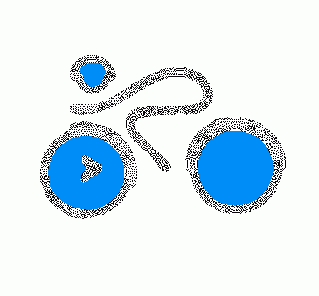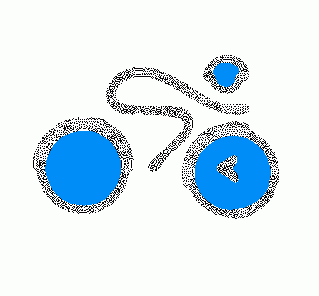| Newsletter - 2016 Archive |
 |
Cycling Club |
 |
| Newsletter - 2016 Archive |
 |
Cycling Club |
 |
Next--->
|
The Flagstaff 600 - Another Wonderful Adventure There are as many reasons to be a randonneur as there are folks who do it. One of my reasons, and I know Barry Chase concurs, is to have an adventure. As a noun, an adventure is an unusual and exciting experience that usually involves the exploration of unknown territory. Riding brevets in southern B.C. and Washington State, for the most part, no longer qualify as unknown territory. As the riding season was winding down, Barry Chase was in need of a 600 to complete his Super Series, and knowing that I place a high value on "adventure", he sent me a list of dates of the remaining 600km brevets to be held in the USA and asked if I was interested in doing one. Only the AZ, Flagstaff 600 fit both our schedules. The route looked interesting, looping NE from Flagstaff through the Navaho Nation Lands (desert) for the first 400km and through the pine and juniper forests to the NW - all at elevations between 5000' and the low 8000s (mostly above 7000') with some of the route following the famous Route # 66. This fit the bill as an adventure and indeed it was! The trip started with a flight from Bellingham (Allegiant Airlines... ugh!) to Las Vegas where we overnighted. L.V. is a tough place to rest up for a two day ride. We enjoyed time on the "Strip" and had a wonderful meal at an outdoor French restaurant across from Bellagio's where we could watch the choreographed fountain show. We were early to bed, not the norm in L.V., but we planned for an early departure to drive the four hours to Flagstaff. I had done a cycle/hike/kayak vacation in the L.V. area last spring and had found a funky little cafe in Boulder, NV. We decided to stop there for breakfast. The food was great as was the local ambience. As we approached Flagstaff, we decided to follow the brevet route the last 20km into town. We were glad we did as it would have been somewhat confusing in the dark. We also found an error in the route sheet, which we pointed out to the organizer. Six riders started - the resident organizer, two riders from the Phoenix area, one from Oklahoma, plus Barry and I. The first 15km of the route meandered through an area of hobby farms/micro ranches. This was followed by what was essentially a 2000'/55km descent to the town of Leupp (elevation approx. 5000'). That was the last of any sustained downhill we were to see for over 200km. It was now a long climb up to Mesa #1, then up to Mesa # 2 and onto Mesa # 3. The final 5km climb to a Hopi Cultural Center left the lungs and legs burning. The ride from Leupp to the Cultural Centre was wide open desert. As far as one could see, which was often 15-20km in every direction, the only sign of human presence was the strip of asphalt we were standing on - absolutely nothing but desert sand, rocks and hardy plants. There was nowhere to get food or water between Leupp and the Center. There was hardly any traffic, and we didn't see a single semi. The road was ours. We had the sense that in a car or on a motorbike one simply passed through country like this; at pedal power speed, one starts to become part of the place. You start to see the nuances of the land and the influence of water. Although water is in short supply, when it does come, it is overpowering and is the local sculptor so to speak. This was magical. We didn't reach the Cultural Centre until late afternoon; what a sanctuary, an air conditioned place to rest (The outside temperatures were in the high 30Cs, low 40Cs), refill our water bottles, and throw back a cold Coke. The staff were welcoming and very curious. What brought these old guys (sorry Barry) in lycra way out here? We got a profound sense of their ownership and attachment to this land and were warmly invited to come back. The climbing was not over. We had several steep, short descents only to climb right back up. On paper this route did not have that much climbing (13,000'), but it sure dished it out. We had one more interesting experience leaving the Navaho Lands. We had stopped in Dilkon, one of the last native communities, at a pizza parlor recommended by the organizer. Waiting for the pizza, we took the opportunity to gear up for night riding when I was approached by a disheveled looking older man. I was busy with the bike and (in hindsight) insensitively brushed him off. We devoured the pizza, and when we returned to our bikes, he had returned. He approached Barry who chose to engage in a quiet conversation with the man. After a few minutes, the man left. Barry turned towards me with a most amazing look on his face. He said, "I've just been blessed by a Hopi elder." Barry was clearly humbled. Within a few kilomtres of leaving Dilkin, we began to see lights in the distance. We were somewhat dumfounded as to where they were coming from. It turned out they were from the town of Leupp, 34km away and 2500' below us. There were no trees in the desert to block the view. At Leupp we had a 70km, 2000' climb back to Flagstaff..ugh!. What a way to finish the day and it was getting cold. As we climbed, the temperature just kept dropping all the way down to 0C. We arrived back at the control (our motel) at 2:30AM. Neither of us slept well, so we were up at 5:30ish. We raided the motel breakfast offerings and were on the road with an hour to spare before the control officially closed. The sun was up, but it was cold. Day #2 was only 200km, but it started almost immediately with a climb to the highest point on the entire route, just over 8000'. The climb was quite gradual through open (by coastal standards) pine forests. The 2500' descent to the town of Valle was sublime. Barry vanished ahead of me as he always does on long descents. Descending alone was exhilarating, swiping through the corners just letting the bike go. The stretch from Valle to Williams on paper looked to be a gradual descent; it was anything but. Yes it was overall downhill, but it was repeatedly punctuated with short steep climbs. As the main road from Interstate Hwy # 40 to the Grand Canyon National Park, it was very busy. It seemed to take forever. The unexplained flat I had approx. 10km from Williams didn't help. Williams is a historical town on old Route # 66. It has seen better days! We were on the home stretch (approx. 65km to go) where the route took us onto the Route 66 of old which included 8km of gravel to the highest elevation on entire Route # 66 (7400'). Near the high point, we had a real scare. Out of nowhere, three very aggressive dogs (of good size) were on us. In their quest to get at Barry, they nearly took me down. It's hard to accelerate as rapidly as one would like going uphill on gravel. Just as we exited the last section of gravel and crossed the umpteenth cattle guard, Barry flatted... darn. It was now hot, and the route sheet indicated there was a McDonald's ahead; why it was there was anybody's guess. It was air conditioned and the milkshakes hit the spot. At this point, the route was onto Interstate # 40 for 10km, and was it UGLY! The speed limit was 75MPH, and there were literally trains of semis. The shoulder was the most broken up jumble of asphalt I had ever ridden on, absolutely disgusting. The fact neither of us went down, bent a rim or had a flat was amazing. As we approached Flagstaff, the shoulder improved markedly but was littered with the wire debris of blown truck tires. Barry flatted again. The repair was complicated when one of his spare tubes wouldn't hold air. We were now at the western boundary of Flagstaff where we meandered through the campus of Northern Arizona University and an industrial area along the BNSF railway back to the finish control. To our surprise, we were met by the ride organizer who filled us in on the fate of the other riders. There were four finishers; the two AZ riders from the Phoenix area had DNFed. We closed the evening with a Denny's dinner, a celebratory beer, and a good night's sleep. It was early to rise as we had a plane to catch back in Las Vegas. We decided to drive some of the maintained Route # 66 from west of Williams back to Kingman (75miles) rather than drive Interstate # 40. The road was quiet and in great "cycling" condition. We passed through Seligman. It was a one horse town but on the tourist map. There were people by the dozens walking from one end of the town to the other (three blocks). This was 1950s Route # 66; it looked like a movie set. There must have been 20 tour buses lining the main (only) street. Leaving Seligman, the next town was a native community named Peach Springs. We'd passed a solo cycle tourist just before P.S. who rolled into town as we were having a coffee. The rider was a 24 year old woman from Belgium doing a cross country ride. She was free camping as much as possible and said she hadn't had any problems or safety concerns. Impressive!!!! This was touring as it should be. It was indeed a grand adventure. We are already searching for next year's adventure -perhaps a 600 or 1000 in Nebraska!
- October 5, 2016 |